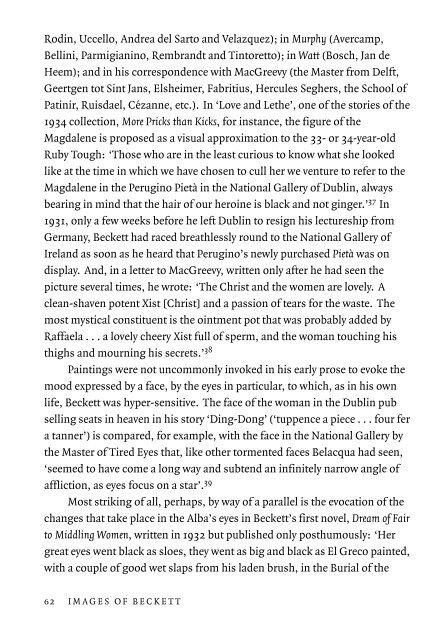You also want an ePaper? Increase the reach of your titles
YUMPU automatically turns print PDFs into web optimized ePapers that Google loves.
Rodin, Uccello, Andrea del Sarto and Velazquez); in Murphy (Avercamp,<br />
Bellini, Parmigianino, Rembrandt and Tintoretto); in Watt (Bosch, Jan de<br />
Heem); and in his correspondence with MacGreevy (the Master from Delft,<br />
Geertgen tot Sint Jans, Elsheimer, Fabritius, Hercules Seghers, the School <strong>of</strong><br />
Patinir, Ruisdael, Cézanne, etc.). In ‘Love and Lethe’, one <strong>of</strong> the stories <strong>of</strong> the<br />
1934 collection, More Pricks than Kicks, for instance, the figure <strong>of</strong> the<br />
Magdalene is proposed as a visual approximation to the 33- or 34-year-old<br />
Ruby Tough: ‘Those who are in the least curious to know what she looked<br />
like at the time in which we have chosen to cull her we venture to refer to the<br />
Magdalene in the Perugino Pietà in the National Gallery <strong>of</strong> Dublin, always<br />
bearing in mind that the hair <strong>of</strong> our heroine is black and not ginger.’ 37 In<br />
1931, only a few weeks before he left Dublin to resign his lectureship from<br />
Germany, <strong>Beckett</strong> had raced breathlessly round to the National Gallery <strong>of</strong><br />
Ireland as soon as he heard that Perugino’s newly purchased Pietà was on<br />
display. And, in a letter to MacGreevy, written only after he had seen the<br />
picture several times, he wrote: ‘The Christ and the women are lovely. A<br />
clean-shaven potent Xist [Christ] and a passion <strong>of</strong> tears for the waste. The<br />
most mystical constituent is the ointment pot that was probably added by<br />
Raffaela ...alovely cheery Xist full <strong>of</strong> sperm, and the woman touching his<br />
thighs and mourning his secrets.’ 38<br />
Paintings were not uncommonly invoked in his early prose to evoke the<br />
mood expressed by a face, by the eyes in particular, to which, as in his own<br />
life, <strong>Beckett</strong> was hyper-sensitive. The face <strong>of</strong> the woman in the Dublin pub<br />
selling seats in heaven in his story ‘Ding-Dong’ (‘tuppence a piece . . . four fer<br />
a tanner’) is compared, for example, with the face in the National Gallery by<br />
the Master <strong>of</strong> Tired Eyes that, like other tormented faces Belacqua had seen,<br />
‘seemed to have come a long way and subtend an infinitely narrow angle <strong>of</strong><br />
affliction, as eyes focus on a star’. 39<br />
Most striking <strong>of</strong> all, perhaps, by way <strong>of</strong> a parallel is the evocation <strong>of</strong> the<br />
changes that take place in the Alba’s eyes in <strong>Beckett</strong>’s first novel, Dream <strong>of</strong> Fair<br />
to Middling Women, written in 1932 but published only posthumously: ‘Her<br />
great eyes went black as sloes, they went as big and black as El Greco painted,<br />
with a couple <strong>of</strong> good wet slaps from his laden brush, in the Burial <strong>of</strong> the<br />
62 IMAGES OF BECKETT


